Statistical Analysis of SF Occurrence in Middle and Low Latitudes Using Bayesian Network Automatic Identification
Abstract
1. Introduction
2. Materials
3. Methods
3.1. The Naive Bayes Classifier Introduction
3.2. Naive Bayesian Classifier Training and Features Extraction
3.2.1. Extract Feature Values
3.2.2. Training Bayesian Classifier
3.2.3. Extract the Indexes of SF
4. Results
5. Discussion
6. Conclusions
- Our results showed that SF mainly occurs at the local nighttime and the occurrence rate of SF at Wuhan is evidently smaller than that at the other four stations. In addition, the occurrence rate of SF also shows an asymmetry in the nighttime: SF occurred more easily in the post-midnight hours when compared with the pre-midnight period, consistent with previous studies.
- There is a peak of occurrence of SF in the summer in I-Cheon, Jeju, Sanya, and Wuhan; however, the Mohe station has the highest occurrence rate of SF in December. The different seasonal variations of SF might be due to the different geographic local conditions and formation mechanisms at these latitudes: Mohe is located inland at a mid-high latitude, so AGW which comes from the lower atmosphere should be different from that of other stations, contributing to the different seasonal characteristics of SF in these stations.
- The most intense FSF appeared in the height range of 220–300 km in these stations, although there are different magnitude extensions in different region. Most FSF occurs during the post-midnight hours in the summer and is distributed more symmetrical around midnight in the winter in Mohe, I-Cheon, and Jeju. By contrast, it is more symmetrical around midnight in the summer at Sanya. As Sanya is located in the equatorial low latitudes, local ionospheric disturbances induced by atmospheric gravity waves and medium-scale traveling ionospheric disturbances (MSTIDs) induced by Perkins instability during the nighttime might contribute to the local time difference of SF in the summer.
- The RSF mainly appeared in the frequency range of 1–7 Mhz with different magnitude extensions in different regions. In particular, the RSF covers a large frequency range of 1–13 Mhz in Sanya, and this phenomenon is most apparent in the equinox, indicating the frequently SSF occurrence in the equinox at Sanya. Moreover, the occurrence rate of mid-latitude SF reached its maximum in the midnight to post-midnight periods, confirming the previous results.
- SF also appeared in the daytime in these stations, and AGW, TID, geomagnetic inclination/declination, etc. might contribute to the daytime SF formation. Due to the limitation of data, multi-instrument observations and simulations are needed to provide a statistical picture and to study the physical mechanisms of daytime SF in the future.
Author Contributions
Funding
Data Availability Statement
Acknowledgments
Conflicts of Interest
References
- Booker, H.G. Turbulence in the ionosphere with applications to meteor trails, radio-star scintillation, auroral radar echoes, and other phenomena. J. Geophys. Res. 1956, 61, 673–705. [Google Scholar] [CrossRef]
- Ratcliffe, J.A. An Introduction to the Ionosphere and Magnetosphere; Cambridge University Press: Cambridge, UK, 1972. [Google Scholar]
- Booker, H.G.; Wells, H.W. Scattering of radio waves in the F region of ionosphere. Terr. Magn. Atmos. Electr. 1938, 43, 249. [Google Scholar] [CrossRef]
- Farley, D.T.; Balsley, B.B.; Woodman, R.F.; McClure, J.P. Equatorial SF, implications of VHF radar observations. J. Geophys. Res. 1970, 75, 7199–7216. [Google Scholar] [CrossRef]
- Sobral, J.H.A.; Abdu, M.A.; Zamlutti, C.J.; Batista, I.S. Association between plasma bubble irregularities and airglow disturbances over Brazilian low latitudes. Geophys. Res. Letts. 1980, 1, 980–982. [Google Scholar] [CrossRef]
- Abdu, M.A.; Batista, I.S.; Sobral, J.H.A. A new aspects of magnetic declination control on equatorial spread F and F region dynamo. J. Geophys. Res. 1992, 97, 14897–14904. [Google Scholar] [CrossRef]
- Abdu, M.A. Major phenomena of the equatorial ionosphere–thermosphere system under disturbed conditions. J. Atmos. Sol. Terr. Phys. 1997, 13, 1505–1519. [Google Scholar] [CrossRef]
- Abdu, M.A. Outstanding problems in the equatorial ionosphere– thermosphere system relevant to spread F. J. Atmos. Sol. Terr. Phys. 2001, 63, 869–884. [Google Scholar] [CrossRef]
- Abdu, M.A.; Kherani, E.A.; Batista, I.S.; Sobral, J.H.A. Equatorial evening prereversal vertical drift and spread F suppression by disturbance penetration electric fields. Geophys. Res. Lett. 2009, 36, L19103. [Google Scholar] [CrossRef]
- Huang, C.-S.; Kelley, M.C. Nonlinear evolution of equatorial spread F:1 On the role of plasma instabilities and spatial resonance associated with gravity wave seeding. J. Geophys. Res. 1996, 98, 15631–15642. [Google Scholar] [CrossRef]
- Huang, C.-S.; Foster, J.C.; Kelley, M.C. Long-duration penetration of the interplanetary electric field to the low-latitude ionosphere during the main phase of magnetic storms. J. Geophys. Res. 2005, 110, A11309. [Google Scholar] [CrossRef]
- Fejer, B.G.; Scherliess, L.; de Paula, E.R. Effects of the vertical plasma drift velocity on the generation and evolution of equatorial spread F. J. Geophys. Res. 1999, 104, 19854–19869. [Google Scholar] [CrossRef]
- Huba, J.D.; Joyce, G.; Krall, J. Three-dimensional equatorial spread F modeling. Geophys. Res. Lett. 2008, 35, L10102. [Google Scholar] [CrossRef]
- Tsunoda, R.T. On equatorial spread F: Establishing a seeding hypothesis. J. Geophys. Res. 2010, 115, A12303. [Google Scholar] [CrossRef]
- Yokoyama, T.; Shinagawa, H.; Jin, H. Nonlinear growth, bifurcation, and pinching of equatorial plasma bubble simulated by three-dimensional high-resolution bubble model. J. Geophys. Res. Space Phys. 2014, 119, 10474–10482. [Google Scholar] [CrossRef]
- Hysell, D.L.; Milla, M.; Kuyeng, K. Radio Beacon and Radar Assessment and Forecasting of Equatorial F Region Ionospheric Stability. J. Geophys. Res. Space Phys. 2019, 124, 9511–9524. [Google Scholar] [CrossRef]
- Wu, K.; Xu, J.Y.; Zhu, Y.J.; Yuan, W. Occurrence characteristics of branching structures in equatorial plasma bubbles: A statistical study based on all-sky imagers in China. Earth Planet. Phys. 2021, 5, 407–415. [Google Scholar] [CrossRef]
- Mohandesi, A.; Knudsen, D.; Skone, S.; Langley, R.; Yau, A. Altitude Distribution of Large and Small-Scale Equatorial Ionospheric Irregularities Sampled from an Elliptical Low-Earth Orbit. J. Geophys. Res. Space Phys. 2022, 127, e2021JA030104. [Google Scholar] [CrossRef]
- Dungey, J.W. Convective diffusion in the equatorial F region. J. Atmos. Terr. Phys. 1956, 9, 304–310. [Google Scholar] [CrossRef]
- Fejer, B.G.; Kelley, M.C. Ionospheric irregularities. Rev. Geophys. 1980, 18, 401–454. [Google Scholar] [CrossRef]
- Sultan, P.J. Linear theory and modeling of the Rayleigh-Taylor instability leading to the occurrence of equatorial spread F. J. Geophys. Res. 1996, 101, 26875. [Google Scholar] [CrossRef]
- Huba, J. Generalized Rayleigh-Taylor Instability: Ion Inertia, Acceleration Forces, and E Region Drivers. J. Geophys. Res. Space Phys. 2022, 127, e2022JA030474. [Google Scholar] [CrossRef]
- Woodman, R.F.; Hoz, C.L. Radar observations of F region equatorial irregularities. J. Geophys. Res. 1976, 81, 5447–5466. [Google Scholar] [CrossRef]
- Singh, S.; Johnson, F.S.; Power, R.A. Gravity wave seeding of equatorial plasma bubbles. J. Geophys. Res. 1997, 102, 7399–7410. [Google Scholar] [CrossRef]
- Tsunoda, R.T. Satellite traces: An ionogram signature for large-scale wave structure and a precursor for equatorial spread F. Geophys. Res. Lett. 2008, 35, L20110. [Google Scholar] [CrossRef]
- Aveiro, H.C.; Hysell, D.L.; Park, J.; Lühr, H. Equatorial spread F related currents: Three-dimensional simulations and observations. Geophys. Res. Lett. 2011, 38, L21103. [Google Scholar] [CrossRef]
- Perkins, F. Spread F and ionospheric currents. J. Geophys. Res. 1973, 78, 218–226. [Google Scholar] [CrossRef]
- Bowman, G.G. A review of some recent work on mid-latitude spread-F occurrence as detected by ionosondes. J. Geomagn. Geoelectr. 1990, 42, 109–138. [Google Scholar] [CrossRef]
- Yokoyama, T.; Yamamoto, M.; Fukao, S.; Cosgrove, R.B. Three dimensional simulation on generation of polarization electric field in the midlatitude E-region ionosphere. J. Geophys. Res. 2004, 109, A01309. [Google Scholar] [CrossRef]
- Balan, N.; Otsuka, Y.; Nishioka, M.; Liu, J.Y.; Bailey, G.J. Physical mechanisms of the ionospheric storms at equatorial and higher latitudes during the recovery phase of geomagnetic storms. J. Geophys. Res. 2013, 118, 2660–2669. [Google Scholar] [CrossRef]
- Zhou, C.; Tang, Q.; Huang, F.Q.; Liu, Y.; Gu, X.D.; Lei, J.H.; Ni, B.B.; Zhao, Z.Y. The simultaneous observations of nighttime ionospheric E region irregularities and F region medium-scale traveling ionospheric disturbances in midlatitude China. J. Geophys. Res. 2018, 123, 5195–5209. [Google Scholar] [CrossRef]
- Liu, Y.; Zhou, C.; Xu, T.; Wang, Z.K.; Tang, Q.; Deng, Z.X.; Chen, G.Y. Investigation of midlatitude nighttime ionospheric E-F coupling and interhemispheric coupling by using COSMIC GPS radio occultation measurements. J. Geophys. Res. 2020, 125, e2019JA027625. [Google Scholar] [CrossRef]
- Dabas, R.S.; Das, R.M.; Sharma, K.; Garg, S.C.; Devasia, C.V.; Subbarao, K.S.V.; Niranjan, K.; Rama Rao, P.V.S. Equatorial and low latitude spread-F irregularity characteristics over the Indian region and their prediction possibilities. J. Atmos. Sol. Terr. Phys. 2007, 69, 685–696. [Google Scholar] [CrossRef]
- Hoang, T.L.; Abdu, M.A.; MacDougall, J.; Batista, I.S. Longitudinal differences in the equatorial spread F characteristics between Vietnam and Brazil. Adv. Space Res. 2010, 45, 351–360. [Google Scholar] [CrossRef]
- Tulasi Ram, S.; Rama Rao, P.V.S.; Prasad, D.S.V.V.D.; Niranjan, K.; Gopi Krishna, S.; Sridharan, R.; Ravindran, S. Local time dependent response of postsunset ESF during geomagnetic storms. J. Geophys. Res. 2008, 113, A07310. [Google Scholar] [CrossRef]
- Balan, N.; Liu, L.; Le, H. A brief review of equatorial ionization anomaly and ionospheric irregularities. Earth Planet. Phys. 2018, 2, 1–19. [Google Scholar] [CrossRef]
- King, G.A. Spread-F on ionograms. J. Atmos. Terr. Phys. 1970, 32, 209–221. [Google Scholar] [CrossRef]
- Su, S.Y.; Yeh, H.C.; Heelis, R.A. ROCSAT 1 ionospheric plasma and electrodynamics instrument observations of equatorial spread F: An early transitional scale result. J. Geophys. Res. 2001, 106, 29513–29519. [Google Scholar] [CrossRef]
- Jin, H.; Zou, S.; Chen, G.; Yan, C.; Zhang, S.; Yang, G. Formation and Evolution of Low-Latitude F Region Field-Aligned Irregularities During the 7-8 September 2017 Storm: Hainan Coherent Scatter Phased Array Radar and Digisonde Observations. Space Weather 2018, 16, 648–659. [Google Scholar] [CrossRef]
- Reinisch, B.W.; Huang, X. Automatic calculation of electron density profiles from digital ionograms: 3. Processing of bottomside ionograms. Radio Sci. 1983, 18, 477–492. [Google Scholar] [CrossRef]
- Pezzopane, M.; Scotto, C. Automatic scaling of critical frequency foF2 and MUF(3000)F2: A comparison between Autoscala and ARTIST 4.5 on Rome data. Radio Sci. 2007, 42, RS4003. [Google Scholar] [CrossRef]
- Jiang, C.; Yang, G.; Zhao, Z.; Zhang, Y.; Zhu, P.; Sun, H. An automatic scaling technique for obtaining F2parameters and F1critical frequency from vertical incidence ionograms. Radio Sci. 2013, 48, 739–751. [Google Scholar] [CrossRef]
- Jiang, C.; Yang, G.; Zhou, Y.; Zhu, P.; Lan, T.; Zhao, Z.; Zhang, Y. Software for scaling and analysis of vertical incidence ionograms-ionoScaler. Adv. Space Res. 2017, 59, 968–979. [Google Scholar] [CrossRef]
- Pillat, V.G.; Guimaraes, L.N.F.; Fagundes, P.R. A computational tool for ionosonde CADI’s ionogram analysis. Comput. Geosci. 2013, 52, 372–378. [Google Scholar] [CrossRef]
- Pezzopane, M.; Pillat, V.; Fagundes, P. Automatic scaling of critical frequency foF2 from ionograms recorded at São José dos Campos, Brazil: A comparison between Autoscala and UDIDA tools. Acta Geophys. 2017, 65, 173–187. [Google Scholar] [CrossRef]
- Pillat, V.G.; Fagundes, P.R.; Guimarães, L.N.F. Automatically identification of Equatorial Spread-F occurrence on ionograms. J. Atmos. Sol. Terr. Phys. 2015, 135, 118–125. [Google Scholar] [CrossRef]
- Lan, T.; Zhang, Y.; Jiang, C.; Yang, G.; Zhao, Z. Automatic identification of Spread F using decision trees. J. Atmos Sol.-Terr. Phys. 2018, 179, 389–395. [Google Scholar] [CrossRef]
- Lan, T.; Hu, H.; Jiang, C.; Yang, G.; Zhao, Z. A Comparative Study of Decision Tree, Random Forest, and Convolutional Neural Network for Spread-F Identification. Adv. Space Res. 2020, 65, 2052–2061. [Google Scholar] [CrossRef]
- Scotto, C.; Ippolito, A.; Sabbagh, D. A method for automatic detection of equatorial spread-F in Ionograms. Adv. Space Res. 2019, 63, 337–342. [Google Scholar] [CrossRef]
- Rao, T.V.; Sridhar, M.; Ratnam, D.V. Auto-detection of sporadic E and spread F events from the digital ionograms. Adv. Space Res. 2022, 70, 1142–1152. [Google Scholar] [CrossRef]
- Hajkowicz, L. Morphology of quantified ionospheric range spread-F over a wide range of midlatitudes in the Australian longitudinal sector. Ann. Geophys. 2007, 25, 1125–1130. [Google Scholar] [CrossRef]
- Pezzopane, M.; Zuccheretti, E.; Abadi, P.; de Abreu, A.J.; de Jesus, R.; Fagundes, P.R.; Supnithi, P.; Rungraengwajiake, S.; Nagatsuma, T.; Tsugawa, T.; et al. Low-latitude equinoctial spread-F occurrence at different longitude sectors under low solar activity. Ann. Geophys. 2013, 31, 153–162. [Google Scholar] [CrossRef]
- Wang, G.; Shi, J.; Wang, X.; Shang, S.P. Seasonal variation of spread-F observed in Hainan. Adv. Space Res. 2008, 41, 639–644. [Google Scholar] [CrossRef]
- Lan, T.; Jiang, C.; Yang, G.; Zhang, Y.; Liu, J.; Zhao, Z. Statistical analysis of low-latitude spread F observed over Puer, China, during 2015–2016. Earth Planets Space 2019, 71, 138. [Google Scholar] [CrossRef]
- Guo, B.; Xiao, S.; Shi, J.; Xiao, Z.; Wang, G.; Cheng, Z.; Shang, S.; Wang, Z.; Suo, Y. Comparative study on characteristics of spread-F at low-and mid-latitudes during high and low solar activities over East Asia. Chin. J. Geophys. 2017, 60, 3289–3300. [Google Scholar] [CrossRef]
- Wang, N.; Guo, L.; Ding, Z.; Zhao, Z.; Xu, Z.; Xu, T.; Hu, Y. Longitudinal differences in the statistical characteristics of ionospheric spread-F occurrences at mid-latitude in Eastern Asia. Earth Planets Space 2019, 71, 47. [Google Scholar] [CrossRef]
- Lan, T.; Jiang, C.; Yang, G.; Sun, F.; Xu, Z.; Liu, Z. Latitudinal Differences in Spread F Characteristics at Asian Longitude Sector during the Descending Phase of the 24th Solar Cycle. Universe 2022, 8, 485. [Google Scholar] [CrossRef]
- Sun, W.; Xu, L.; Huang, X. Forecasting of ionospheric vertical total electron content (TEC) using LSTM networks. In Proceedings of the 2017 International Conference on Machine Learning and Cybernetics (ICMLC), Ningbo, China, 9–12 July 2017; pp. 340–344. [Google Scholar]
- Chen, Z.; Jin, M.; Deng, Y. Improvement of a Deep Learning Algorithm for Total Electron Content Maps: Image Completion. J. Geophys. Res. Space Phys. 2019, 124, 790–800. [Google Scholar] [CrossRef]
- Chen, X.; Lei, J.; Ren, D. A Deep Learning Model for the Thermospheric Nitric Oxide Emission. Space Weather 2021, 19, e2020SW002619. [Google Scholar] [CrossRef]
- Li, X.; Zhou, C.; Tang, Q. Forecasting Ionospheric foF2 Based on Deep Learning Method. Remote Sens. 2021, 13, 3849. [Google Scholar] [CrossRef]
- Xia, G.; Liu, M.; Zhang, F.; Zhou, C. CAiTST: Conv-Attentional Image Time Sequence Transformer for Ionospheric TEC Maps Forecast. Remote Sens. 2022, 14, 4223. [Google Scholar] [CrossRef]
- Jiang, C.; Zhang, Y.; Yang, G.; Zhu, P.; Sun, H.; Cui, X.; Song, H.; Zhao, Z. Automatic scaling of the sporadic E layer and removal of its multiple reflection and backscatter echoes for vertical incidence ionograms. J. Atmos. Sol. Terr. Phys. 2015, 129, 41–48. [Google Scholar] [CrossRef]
- Kohavi, R. Scaling Up the Accuracy of Naïve-Bayes Classifiers: A Decision-Tree Hybrid. In Proceedings of the Second International Conference on Knowledge Discovery and Data Mining, Portland, OR, USA, 2–4 August 1996; AAAI Press: Palo Alto, CA, USA, 1996; pp. 202–207. [Google Scholar]
- Piggot, W.R.; Rawer, K. URSI Handbook of Ionogram Interpretation and Reduction. In International Union of Radio Science; United States, Environmental Data Service: Washington, DC, USA, 1978. [Google Scholar]
- Chen, W.S.; Lee, C.C.; Chu, F.D.; Su, S.Y. Spread F, GPS phase fluctuations, and medium-scale traveling ionospheric disturbances over Wuhan during solar maximum. J. Atmos Sol. Terr. Phys. 2011, 73, 528–533. [Google Scholar] [CrossRef]
- Paul, K.S.; Haralambous, H.; Oikonomou, C.; Paul, A.; Belehaki, A.; Ioanna, T.; Kouba, D.; Buresova, D. Multi-station investigation of spread F over Europe during low to high solar activity. J. Space Weather Space Clim. 2018, 8, A27. [Google Scholar] [CrossRef]
- Bhaneja, P.; Earle, G.D.; Bullett, T.W. Statistical analysis of midlatitude spread F using multi-station digisonde observations. J. Atmos Sol.-Terr. Phys. 2018, 167, 146–155. [Google Scholar] [CrossRef]
- Igarashi, K.; Kato, H. Solar cycle variations and latitudinal dependence on the mid-latitude spread-F occurrence around Japan. In The XXIV General Assembly; International Union of Radio Science: Kyoto, Japan, 1993. [Google Scholar]
- Huang, W.Q.; Xiao, Z.; Xiao, S.G.; Zhang, D.H.; Hao, Y.Q.; Suo, Y.C. Case study of apparent longitudinal differences of spread F occurrence for two midlatitude stations. Radio Sci. 2011, 46, RS1015. [Google Scholar] [CrossRef]
- Devasia, C.V.; Jyoti, N.; Subbarao, K.S.V. On the plausible linkage of thermospheric meridional winds with equatorial spread F. J. Atmos. Sol. Terr. Phys. 2002, 64, 1–12. [Google Scholar] [CrossRef]
- Liu, Y.; Deng, Z.; Xu, T.; Kong, J.; Zhou, C.; Yao, Y. Daytime F region echoes at equatorial ionization anomaly crest during geomagnetic quiet period: Observations from multi-instruments. Space Weather 2022, 20, e2021SW003002. [Google Scholar] [CrossRef]
- Candido, C.M.N.; Batista, I.S.; Becker-Guedes, F.; Abdu, M.A.; Sobral, J.H.; Takahashi, H. Spread F occurrence over a southern anomaly crest location in Brazil during June solstice of solar minimum activity. J. Geophys. Res. 2011, 116, A06316. [Google Scholar] [CrossRef]
- Shi, J.K.; Wang, G.J.; Reinisch, B.W.; Shang, S.P.; Wang, X.; Zherebotsov, G.; Potekhin, A. Relationship between strong range spread F and ionospheric scintillations observed in Hainan from 2003 to 2007. J. Geophys. Res. 2011, 116, A08306. [Google Scholar] [CrossRef]
- Li, J.; Ma, G.; Maruyama, T.; Li, Z. Mid-latitude ionospheric irregularities persisting into late morning during the magnetic storm on 19 March 2001. J. Geophys. Res. 2012, 117, A08304. [Google Scholar] [CrossRef]
- Kil, H.; Lee, W.K.; Paxton, L.J. Origin and distribution of daytime electron density irregularities in the low-latitude F region. J. Geophys. Res. Space Phys. 2020, 125, e2020JA028343. [Google Scholar] [CrossRef] [PubMed]
- Jiang, C.; Yang, G.; Liu, J.; Yokoyama, T.; Komolmis, T.; Song, H. Ionosonde observations of daytime spread F at low latitudes. J. Geophys. Res. Space Phys. 2016, 121, 12093–12103. [Google Scholar] [CrossRef]
- Yang, G.; Jiang, C.; Lan, T.; Huang, W.; Zhao, Z. Ionosonde observations of daytime spread F at middle latitudes during a geomagnetic storm. J. Atmos. Terr. Phys. 2018, 179, 174–180. [Google Scholar] [CrossRef]
- Xiao, S.; Shi, J.; Zhang, D.; Hao, Y.; Huang, W. Observational study of daytime ionospheric irregularities associated with typhoon. Sci. China Technol. Sci. 2012, 55, 1302–1304. [Google Scholar] [CrossRef]
- Huang, C.S.; de La Beaujardier, O.; Roddy, P.A.; Hunton, D.E.; Ballenthin, J.O.; Hairston, M.R. Long-lasting daytime equatorial plasma bubbles observed by the C/NOFS satellite. J. Geophys. Res. 2013, 118, 2398–2408. [Google Scholar] [CrossRef]
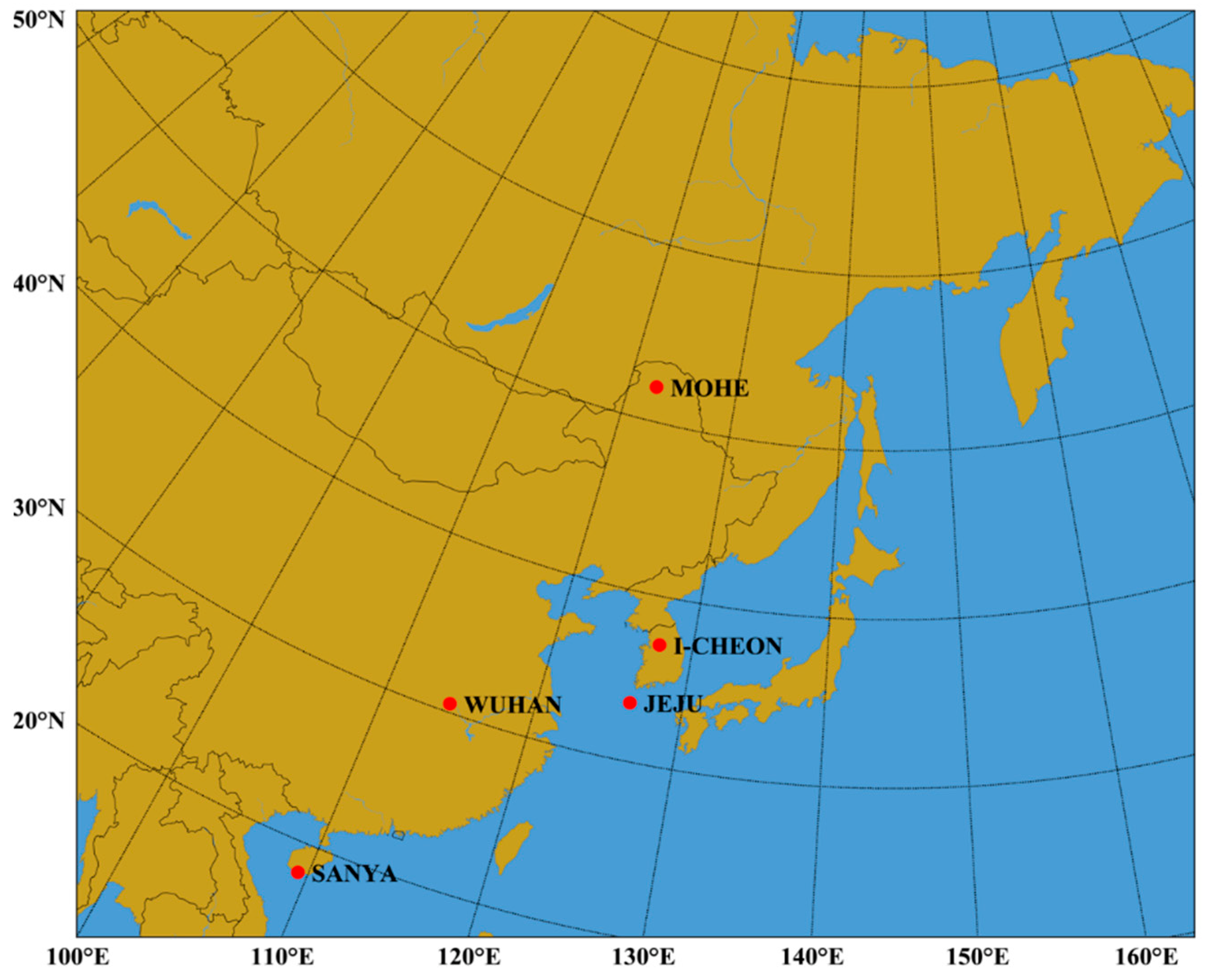
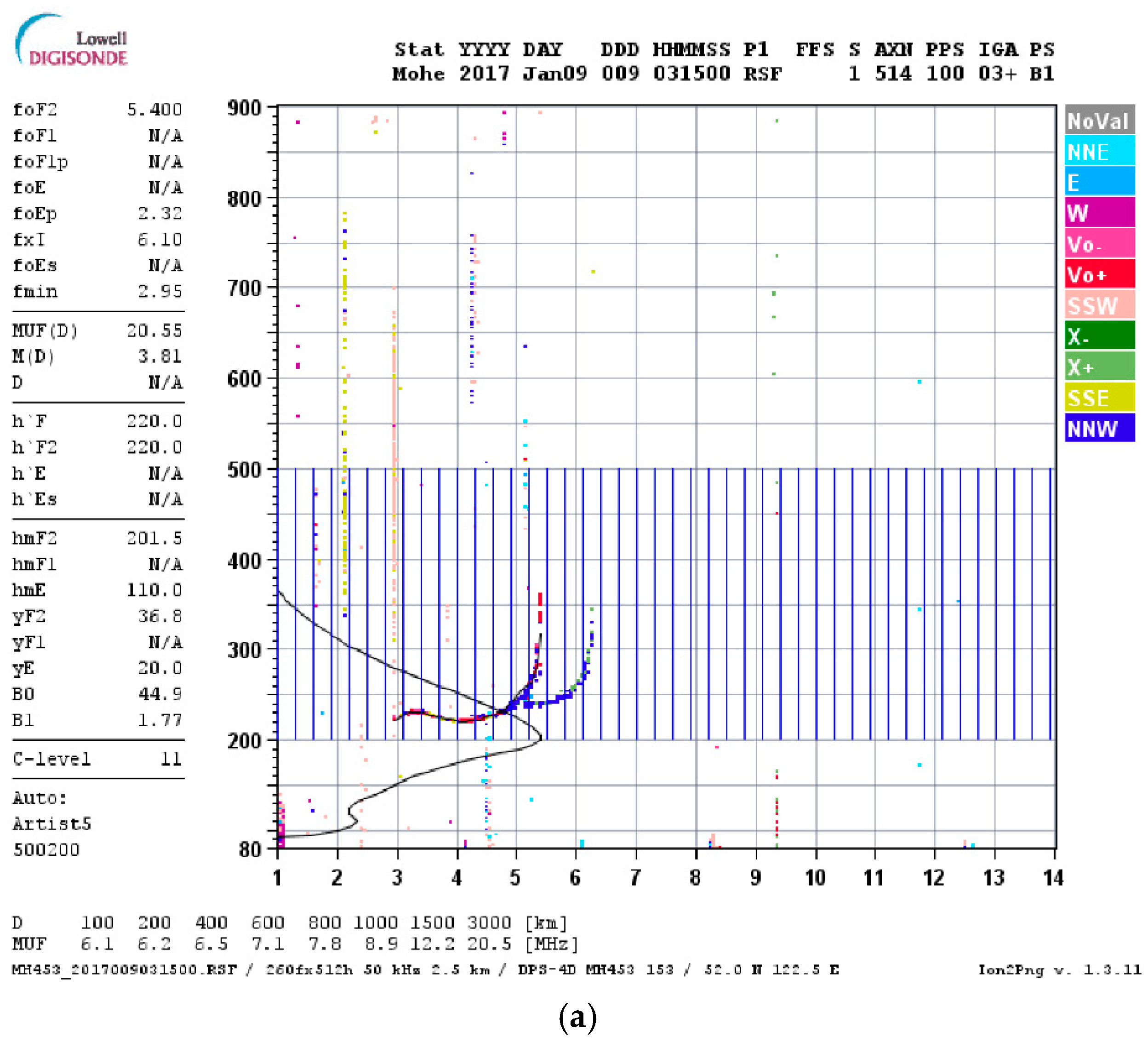
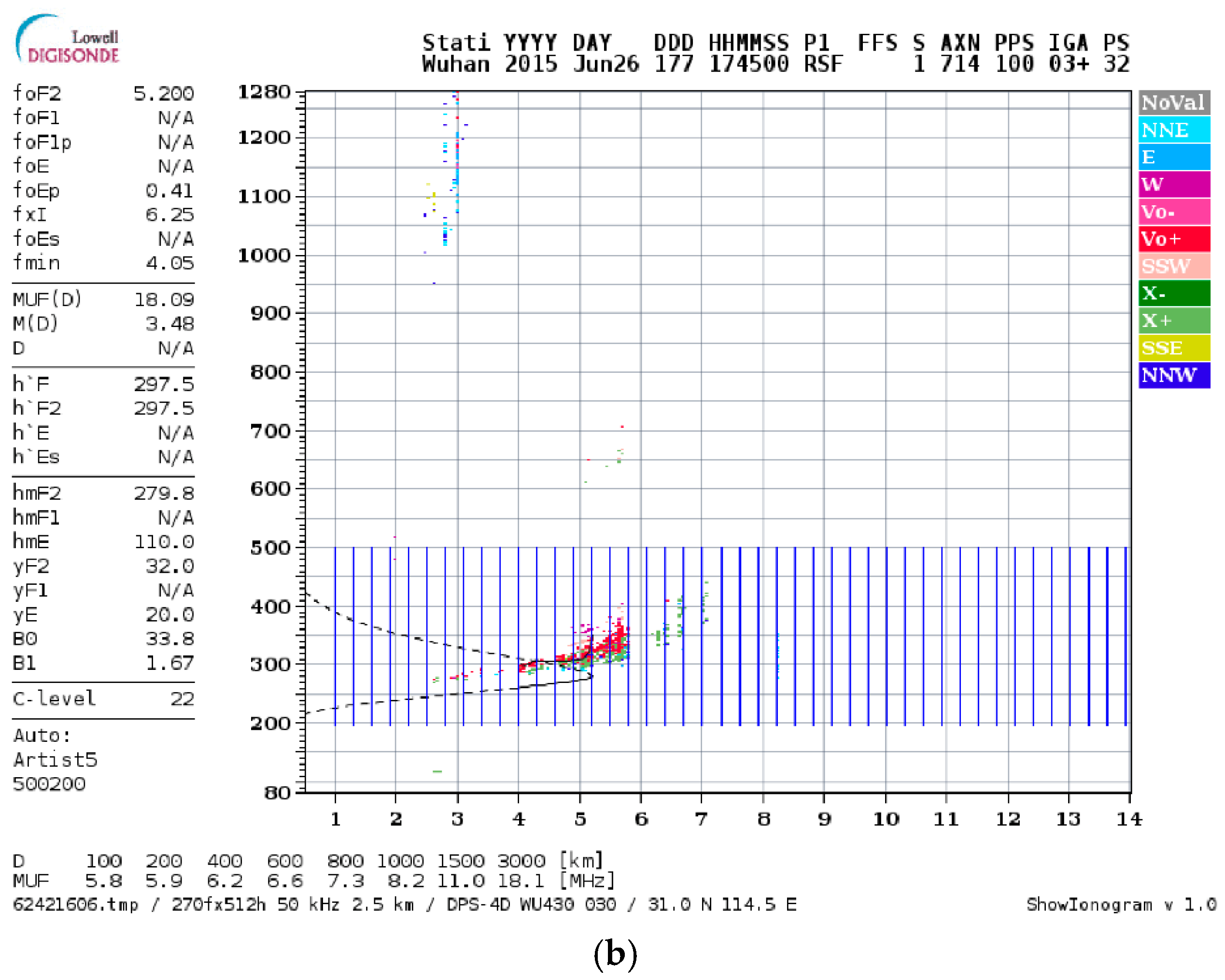

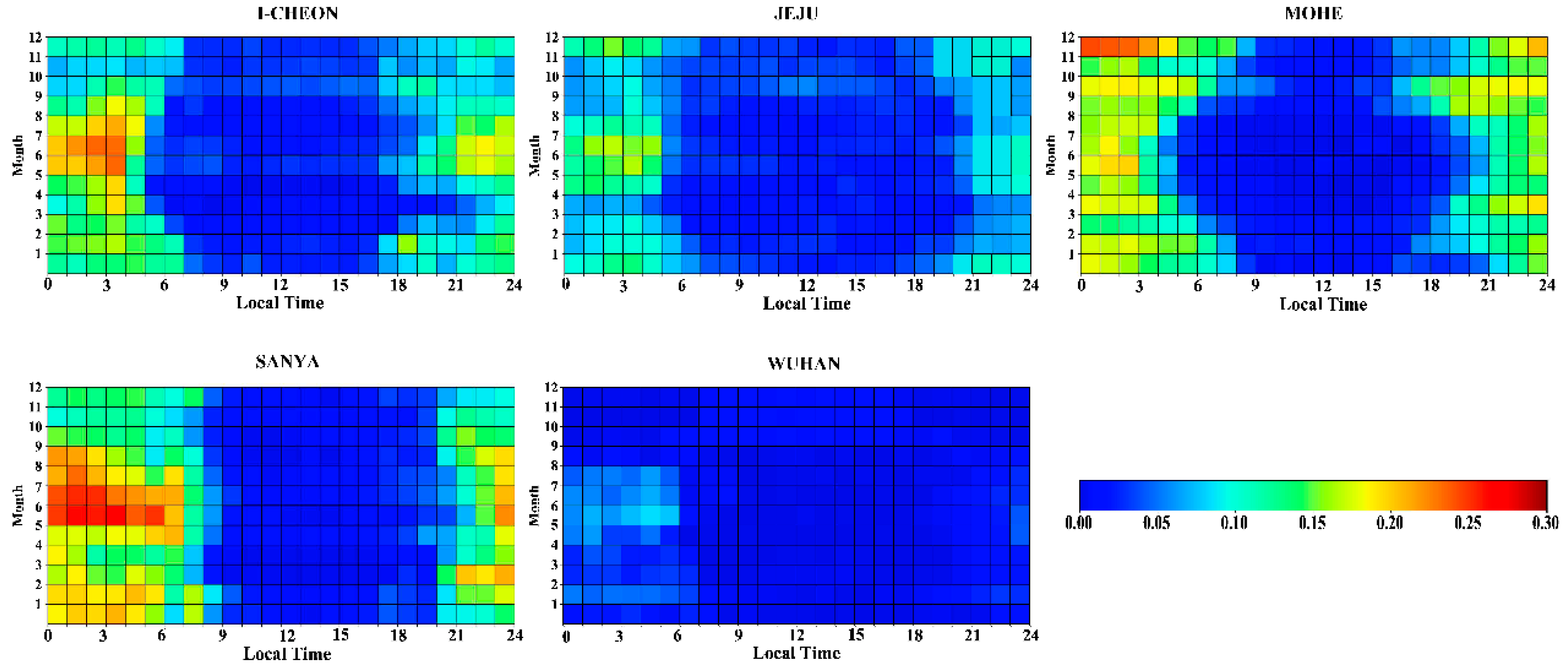
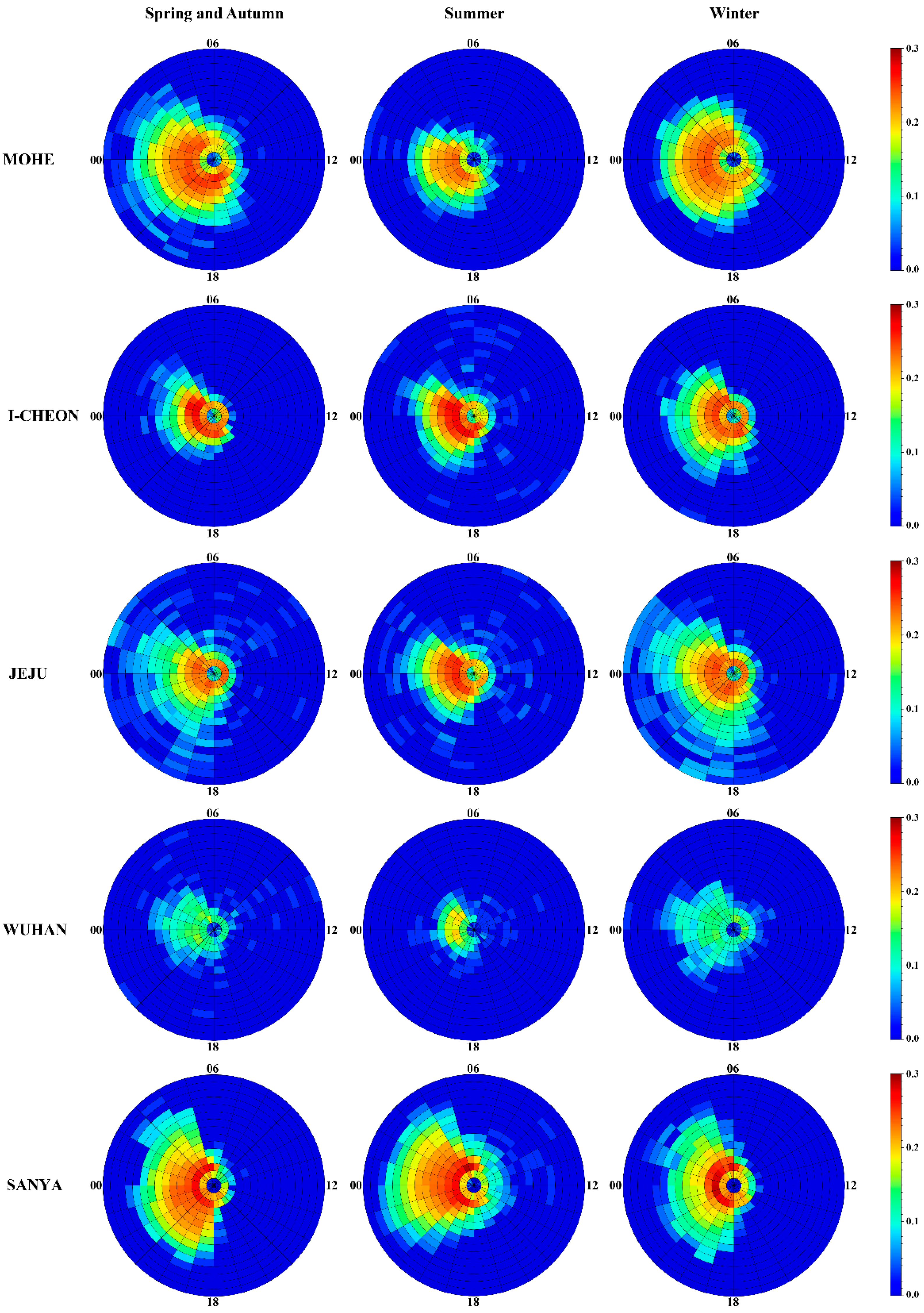
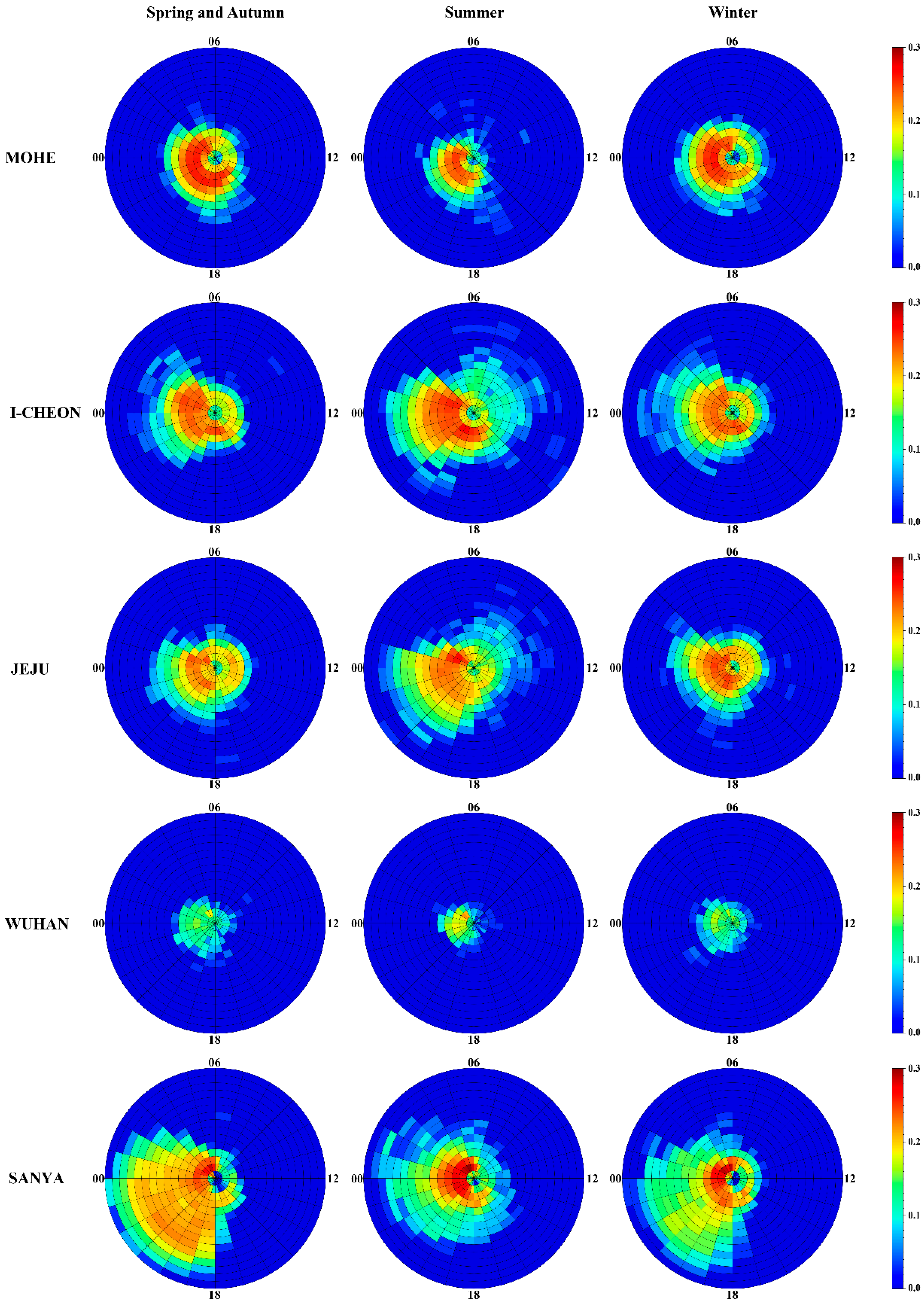
| Station | Geographic Latitude/° | Geographic Longitude/° | Geomagnetic Latitude/° |
|---|---|---|---|
| Mohe | 52.00 | 122.52 | 42.68 |
| I-Cheon | 37.14 | 127.54 | 28.07 |
| Jeju | 33.43 | 126.30 | 24.31 |
| Wuhan | 30.50 | 114.40 | 20.99 |
| Sanya | 18.34 | 109.42 | 8.82 |
| Station | Data Period | Data Missing Period |
|---|---|---|
| Mohe | 2013–2018 | January~August in 2013, May~December in year 2018 |
| I-Cheon | 2010–2013 | November and December in 2013 |
| Jeju | 2009–2013 | July, November, and December in 2013 |
| Wuhan | 2013–2018 | / |
| Sanya | 2013–2017 | August in 2013, December in 2016, January, March, May, and June in 2017 |
Disclaimer/Publisher’s Note: The statements, opinions and data contained in all publications are solely those of the individual author(s) and contributor(s) and not of MDPI and/or the editor(s). MDPI and/or the editor(s) disclaim responsibility for any injury to people or property resulting from any ideas, methods, instructions or products referred to in the content. |
© 2023 by the authors. Licensee MDPI, Basel, Switzerland. This article is an open access article distributed under the terms and conditions of the Creative Commons Attribution (CC BY) license (https://creativecommons.org/licenses/by/4.0/).
Share and Cite
Feng, J.; Zhang, Y.; Gao, S.; Wang, Z.; Wang, X.; Chen, B.; Liu, Y.; Zhou, C.; Zhao, Z. Statistical Analysis of SF Occurrence in Middle and Low Latitudes Using Bayesian Network Automatic Identification. Remote Sens. 2023, 15, 1108. https://doi.org/10.3390/rs15041108
Feng J, Zhang Y, Gao S, Wang Z, Wang X, Chen B, Liu Y, Zhou C, Zhao Z. Statistical Analysis of SF Occurrence in Middle and Low Latitudes Using Bayesian Network Automatic Identification. Remote Sensing. 2023; 15(4):1108. https://doi.org/10.3390/rs15041108
Chicago/Turabian StyleFeng, Jian, Yuqiang Zhang, Shuaihe Gao, Zhuangkai Wang, Xiang Wang, Bo Chen, Yi Liu, Chen Zhou, and Zhengyu Zhao. 2023. "Statistical Analysis of SF Occurrence in Middle and Low Latitudes Using Bayesian Network Automatic Identification" Remote Sensing 15, no. 4: 1108. https://doi.org/10.3390/rs15041108
APA StyleFeng, J., Zhang, Y., Gao, S., Wang, Z., Wang, X., Chen, B., Liu, Y., Zhou, C., & Zhao, Z. (2023). Statistical Analysis of SF Occurrence in Middle and Low Latitudes Using Bayesian Network Automatic Identification. Remote Sensing, 15(4), 1108. https://doi.org/10.3390/rs15041108








